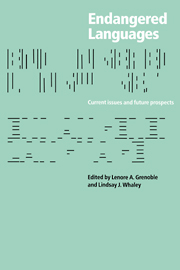Book contents
- Frontmatter
- Contents
- Preface
- List of abbreviations and symbols
- Part I General issues
- Part II Language-community responses
- Part III What is lost: language diversity
- 7 The significance of diversity in language endangerment and preservation
- 8 On endangered languages and the importance of linguistic diversity
- 9 Living words and cartoon translations: Longhouse “texts” and the limitations of English
- 10 Documenting rhetorical, aesthetic, and expressive loss in language shift
- Part IV Mechanisms of language loss
- Appendix
- References
- Index of languages
- Index of names
- General index
10 - Documenting rhetorical, aesthetic, and expressive loss in language shift
Published online by Cambridge University Press: 05 June 2012
- Frontmatter
- Contents
- Preface
- List of abbreviations and symbols
- Part I General issues
- Part II Language-community responses
- Part III What is lost: language diversity
- 7 The significance of diversity in language endangerment and preservation
- 8 On endangered languages and the importance of linguistic diversity
- 9 Living words and cartoon translations: Longhouse “texts” and the limitations of English
- 10 Documenting rhetorical, aesthetic, and expressive loss in language shift
- Part IV Mechanisms of language loss
- Appendix
- References
- Index of languages
- Index of names
- General index
Summary
The maintenance of traditional communicative practices during radical language shift
There has been considerable discussion recently of language endangerment. Language endangerment is a timely issue because, according to Michael Krauss (1992), at least 20 percent – and perhaps as many as 50 percent – of the world's 5,000 to 6,000 languages are already moribund, that is, no longer spoken by children and hence doomed within a century unless learning is revived. Moreover, he estimates that a century from now many more languages will be moribund. This may leave as few as 10 percent of today's languages in genuinely safe condition.
Certainly this loss of diversity is the single most serious problem facing linguists, for it affects their ability to accomplish their two most important tasks: reconstructing linguistic prehistory, and determining the nature, range, and limits of communicative behavior and grammatical competence.
More complicated is its impact on individuals in communities where language shift is under way. Especially as language choice becomes politically and socially polarized, many locate in their ancestral language their social identity, their cultural traditions, their aesthetic and expressive achievements and potential, and the texture of their daily interactions with those around them. Perhaps due to the naturalness of such identifications, it is usually assumed that the loss of language entails a loss of social identity or of culture (e.g. Krauss 1992). Yet there has been relatively little explicit inquiry into the question, leaving little in the way of either theory or empirical experience.
- Type
- Chapter
- Information
- Endangered LanguagesLanguage Loss and Community Response, pp. 234 - 258Publisher: Cambridge University PressPrint publication year: 1998
- 31
- Cited by



